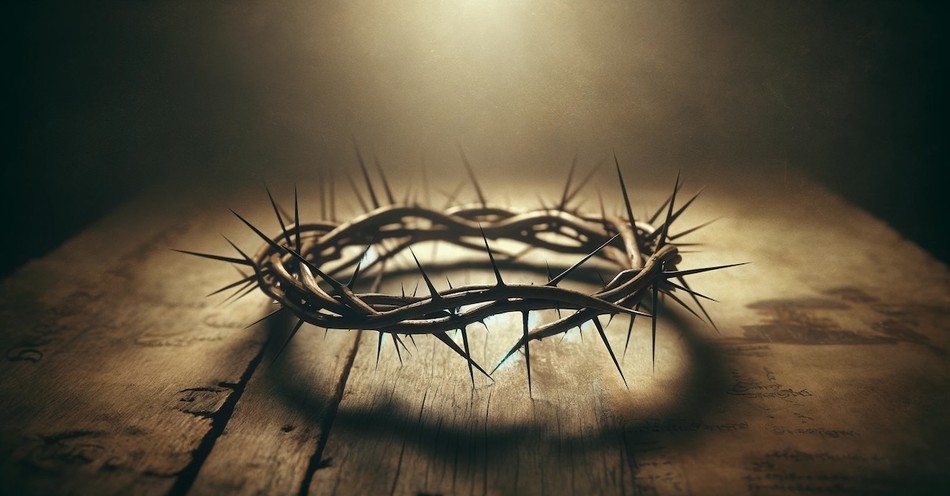On the morning of Jesus’ crucifixion, the Roman soldiers twisted a crown of thorns and placed it on Jesus’ head, openly mocking and ridiculing Jesus as the “King of the Jews” (Matthew 27:29).
Beyond the immense agony caused by long thorns being pressed into the skull of an already bloodied and beaten Jesus, the crown Jesus bore reminds us of the scorn and humiliation the King of kings endured for those He came to save, forsaking His rightful crown of glory for a crown of suffering and shame.
Jesus' Crown of Thorns: Table of Contents
- What Was Jesus' Crown of Thorns?
- Crown of Thorns in the Bible
- What Was It Made Of?
- What Does the Crown of Thorns Symbolize?
- Significance of the Crown of Thorns
What Was Jesus' Crown of Thorns?
The crown of thorns is arguably one of the most iconic images of Christ’s crucifixion. Perhaps more than any form of physical suffering He endured, the crown Jesus bore signifies Christ’s ultimate humility in trading His heavenly crown for a lowly crown of suffering and shame.
It is also the perfect embodiment of what Christ came to earth to fulfill. For in the crown of thorns and the cross He carried, Jesus bore the weight of sin and death, paying the penalty for our sin so that we might be forgiven, reconciled, and redeemed, as was prophesied by the prophet Isaiah,
But He was pierced for our offenses, He was crushed for our wrongdoings; the punishment for our well-being was laid upon Him, and by His wounds we are healed (Isaiah 53:5)
Jesus' Crown of Thorns in the Bible
The crown of thorns is believed to have been fashioned by the Roman soldiers as a mock coronation for a lowly political prisoner (in their eyes). In the hours leading up to His crucifixion, Jesus would sit through two trials, one religious and Jewish, the other political and Roman.
In the first place, the Pharisees and religious leaders brought Jesus before the high priest and Sanhedrin (Matthew 26:57-68; Mark 14:53-65; Luke 22:66-71; John 18:12-24).
As they had found nothing in Jesus’ teaching or ministry to incriminate Him, the Pharisees resorted to “false testimony” from “false witnesses” (Matthew 26:59-60; Mark 14:55-59).
It is when Caiaphas, the high priest, asked Jesus directly, “Are you the Christ, the Son of the Blessed One?” (Mark 14:61) that Jesus replied, “You have said it yourself; nevertheless I tell you, hereafter you will see the Son of Man sitting at the right hand of power, and coming on the clouds of heaven” (Matthew 26:63-64; see also Mark 14:62; Luke 22:67-70).
From here, Scripture tells us that “the high priest tore his robes and said, ‘He has blasphemed!’” To this, the Pharisees and religious leaders replied, “He deserves death!” (Matthew 26:65-66).
The Jewish leaders then proceeded to spit on, slap, beat, and mock Jesus (Psalms 22:7-8).
Calling for Jesus’ death, the Pharisees and high priest delivered Jesus to the Roman governor, Pontius Pilate (Matthew 27:11-26), since the execution of capital punishment was reserved for the Romans.
On multiple occasions, Pilate found that Jesus was undeserving of death. The Pharisees and the mob, however, were insistent, demanding crucifixion (Matthew 27:23).
Pilate then asked Jesus if he was truly the “King of the Jews” (Mark 15:2).
Jesus responded, “It is as you say” (v. 2).
To appease the crowd, Pilate gave permission for Jesus to be scourged and beaten. Here, the Roman soldiers clothed him in a purple robe, spit on him, and mocked him, shouting, “Hail! king of the Jews!” They then fashioned a crown of thorns and placed it on Jesus’ head (John 19:2-3).
What Was the Crown of Thorns Made Of?
Unlike the thorns we might find on a rose bush, the thorns used to fashion Jesus’ crown at His crucifixion were likely from the date palm, whose spikes were very thick and very hard, growing up to twelve inches long in some cases.
Medically, the thorns of a date palm are known to possess toxins that can cause, in addition to, excruciating pain, inflammation, bruising, and tissue damage.
Added to what Jesus had already suffered from being beaten and flogged, the crown of thorns would have caused an almost indescribable pain as Jesus labored, with a heavy cross on His back and crown of thorns on His head, through the streets of Jerusalem to the place where He was ultimately crucified.
What Does the Crown of Thorns Symbolize?
Just days prior to His crucifixion, Jesus had entered Jerusalem to the adulation of those who welcomed Him, shouting, “Hosanna to the Son of David; Blessed is He who comes in the name of the Lord; Hosanna in the highest!” (Matthew 21:9).
For those who celebrated Christ’s arrival, Scripture says, “A very large crowd spread their coats in the road and cut branches from the trees and spread them in the road” (Matthew 21:8).
This was a royal welcome fit for a king, the true King of Israel!
However, the irony of palm branches being used to welcome Jesus as the King of Israel into Jerusalem on Sunday, juxtaposed with palm thorns used to fashion a fake crown that Christ would wear as He was led out of the city on Friday, is astounding!
Furthermore, it is quite possible that many who welcomed Jesus with shouts of “Hosanna” also screamed “Crucify!” to Pontius Pilate just days later.
Not only that, in the Garden of Eden, one of the first symbols and symptoms of the curse brought upon mankind because of Adam’s sin was the presence of “thorns and thistles” to represent the pain and toil connected to man’s labor from then on (Genesis 3:18).
In other parts of the Bible, “thorns” and “thistles” are used to represent the path of those who choose sin over the way of the Lord (Proverbs 22:5).
Little did the Roman soldiers know, their crude and cruel crown of thorns, meant to mock Jesus, actually pointed to the curse and penalty of sin that Jesus Christ wore in our place.
As the Apostle Paul wrote, “He made Him who knew no sin to be sin on our behalf, so that we might become the righteousness of God in Him” (2 Corinthians 5:22).
What Is the Significance of the Crown of Thorns?
The Messiah was promised to be the return of Israel’s true king, a king of the line of David, who would sit on the throne and whose kingdom would last forever (Isaiah 9:7; Jeremiah 30:9; 2 Samuel 7:12-13).
Unfortunately, many in Israel, namely the Pharisees and religious leaders, either failed to recognize or rejected Jesus as the promised Messiah and “cornerstone” (Psalms 118:22). As it is written, “He came to His own and his own did not receive him” (John 1:11).
Therefore, most references to Jesus as the “King of the Jews” in the gospels come from gentiles.
For example, shortly after Jesus’ birth, magi from the east arrived in Jerusalem seeking the Messiah, asking King Herod, “Where is He who has been born King of the Jews? For we saw His star in the east and have come to worship Him” (Matthew 2:2).
Later in Jesus’ life, the gospels tell of a woman who poured expensive perfume over the head and feet of Jesus, using her hair to anoint Him (Matthew 26:6-13; Mark 14:3-9; Luke 7:36-39).
This act of adoration not only pointed to Jesus’ death and eventual burial, which He himself confirmed, but it also reflected the anointed nature of Jesus as God’s chosen king (Psalms 2:2;1 Samuel 10:1; Psalms 23:5; Psalms 89:10).
And when Pilate brought Jesus before the Pharisees and people once more, presenting the beaten beyond recognition man as their king (John 19:14), the Jews again shouted for Pilate to have Him crucified!
Pilate asked, “Shall I crucify your king?” (v. 14).
To this, the Jews responded, “We have no king but Caesar” (John 19:15).
It was a bold and blatant rejection of Jesus Christ as God and king.
At the crucifixion, Pontius Pilate then had a sign placed above the cross, which read in multiple languages, “Jesus of Nazareth, the King of the Jews” (John 19:19).
The Jewish leaders demanded that Pilate take it down, vehemently asserting that Jesus was not their king (John 19:21). Pilate left it in its place.
There, as prophesied, Jesus died among common thieves, ridiculed and scorned. However, through His sacrifice, Jesus forged a path to redemption and the forgiveness of sin.
But we do see Him who was made for a little while lower than the angels, namely, Jesus, because of His suffering death crowned with glory and honor, so that by the grace of God He might taste death for everyone (Hebrews 2:9).
In doing so, Jesus Christ had established himself as the King of the Jews, the King of kings, the King of nations for all time (1 Timothy 1:17, 6:14-16; Hebrews 1:8; Revelation 15:3).
One day, those who have rejected God as King and Jesus as Messiah will know that Christ is the King of kings and Lord of lords (Revelation 17:14). And on that day, as it is written, “Every knee shall bow to Me, And every tongue shall give praise to God” (Romans 14:11; Philippians 2:10).
For further reading:
What Does it Mean That Jesus Is the King of the Jews?
What Do We Know about the Nails Used to Crucify Jesus?
What Is the Medical Account of the Crucifixion?
Photo Credit: Image created using AI Technology via ChatGPT Dall.e


.jpg)

.jpg)
